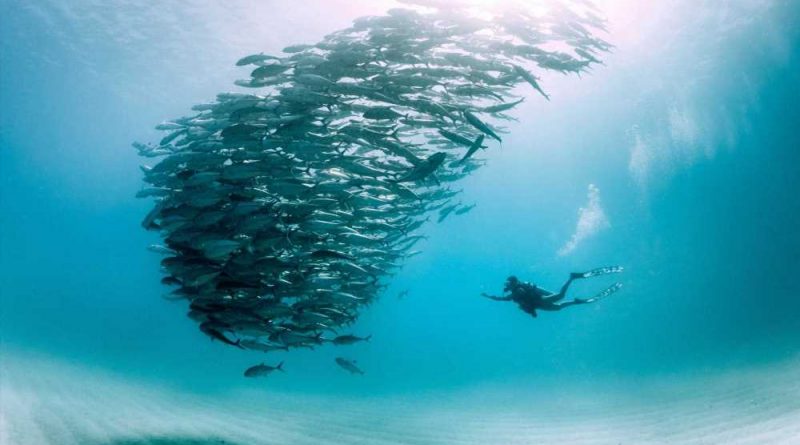How to Responsibly Interact with Marine Life
Seeing wildlife can be a life-changing experience—but it’s important to know how to do it responsibly, to avoid harming those same animals worthy of marveling at. In the last five years, wildlife tourism has undergone a reckoning, as travelers wised up to the inherent cruelty in activities like riding elephants, posing with tigers, and swimming with captive dolphins; and major tour operators like Intrepid Travel, STA Travel, and G Adventures have cut captive wildlife experiences from their trips, while TripAdvisor banned ticket sales for endangered and wild animal attractions in 2016.
Now, the scrutiny aimed at captive wildlife experiences has transcended cages to include animals in their natural habitats—but the absence of physical barriers can make it tricky to understand when a wildlife experience is ethical or not, especially in marine ecosystems.
We’ve reached out to specialists, including scientists and ethical operators, to create a baseline guide to planning and having marine wildlife experiences, compiling where their perspectives overlap; keep these basic protocols in mind as you consider activities that you can feel comfortable participating in.
Look, but don’t touch
“Ethical wildlife tourism means viewing wildlife with no contact or interaction,” says Natalie Kidd, Chief People & Purpose Officer at tour operator Intrepid Travel, which leads many wildlife experiences. This means avoiding any activity that allows touching, feeding, or baiting wildlife, no matter how harmless it may seem.
Keep the bigger picture in mind
Being a responsible tourist goes beyond refraining from petting manatees or snapping off chunks of coral to make into jewelry. “Ethical tourism needs to have a direct gain for the animals,” adds Simon Pierce, a New Zealand-based marine biologist who works with the Marine Megafauna Foundation, a science and conservation non-profit. Fortunately, marine wildlife are often able to inspire that call to action. “When people see marine animals such as whales and dolphins in the wild they are often profoundly moved by the experience and far more motivated than before to actively contribute to the conservation of these animals and their environment,” Kidd notes. Plus, things like national park fees and visitor taxes can be essential in funding conservation efforts; so as you’re scouting around for experiences, make sure to look for ones where part of your payment will go toward the active maintenance and protection of the marine life and their natural habitat.
Recognize that rich ecosystems create rich experiences
A holistic look at ethical wildlife tourism should always include consideration of the ecosystem. “Tourism can have a negative role if tourists don’t respect local wildlife and their habitats,” says Raimundo Espinoza, Founder and Executive Director of Puerto Rico-based organization Conservation ConCiencia, which is dedicated to promoting sustainable development. “Some of the biggest threats sea turtles face in Puerto Rico are loss of habitat due to poorly planned construction and coastal development.” Keeping coastal areas clean can mean reducing plastic use and staying at hotels that emphasize eco-friendly practices, such as those that use renewable energy sources and building materials; truly green resorts can also facilitate direct donations to local marine conservation organizations that spearhead projects to protect wildlife habitats.
Elsewhere in the Caribbean, the Four Seasons Resort Nevis has teamed up with the Sea Turtle Conservancy, a global sea turtle protection organization, to provide guests with an educational but entertaining program that shows what meaningful conservation efforts look like—and offers knowledge that they can take with them even after they leave. Activities include marine biology classes, beach clean-ups, and night walks to watch scientists attach trackers (this part is only available during non-pandemic times). This is distinct from other so-called ethical sea turtle experiences in which tourists are allowed to release hatchlings, “which is a real problem and not helpful to the animal,” says David Godfrey, Executive Director of the Sea Turtle Conservancy. He stresses that only those with expertise and permission in handling wildlife should be the ones to do so.
But ecosystems don’t just comprise wildlife and landscapes; they also include local communities. “Conservation efforts work best if the affected communities actively support and lead the work,” Pierce says, noting that many conservation areas and endangered ocean wildlife are found in the developing world. This approach has been effective in Belize, where most of the marine conservation organizations are locally led, incentivizing the community to participate in solutions that protect waterways. “Given the funding constraints these countries face, sustainable tourism can help support much-needed protection efforts like hiring rangers, while also creating good jobs like tour guides and maintenance.” Empowering local communities to participate in and benefit from conservation is just as fundamental to ethical tourism as not touching wildlife.
Avoid experiences with captive animals
Despite waning popularity of captive wildlife experiences, dolphins and other marine life remain in cages across the world. Typically, tourists pay to watch dolphins perform tricks, or to get in the water with them to pose for a photo. “I do not believe it is ethical to hold dolphins in captivity, and I do not think it is safe to swim with dolphins in a captive space,” says Angie Gullan, founder of Dolphin Encountours Research Center in Mozambique, which follows a strict code of conduct—including a no feed, no touch, and no chase policy—when bringing tourists to see wild pods of dolphins.
When it comes to wildlife sanctuaries, there can sometimes be a gray area (or what seems like one) in which there may be a legitimate reason for holding an animal captive, like an injury that temporarily prohibits it from surviving in the wild. Still, there are ways to tell when those animals are being exploited. “Genuine wildlife sanctuaries have a defined conservation benefit to keeping the animals in captivity, and they do not use the animals for interactions with customers or in performances,” says Natalie Kidd of Intrepid Travel. Travelers may be able to see them, but only in the context of their manmade environment, rather than being put on display.
Do your research before making any plans
There are plenty of people out there ready to separate tourists from their money at the expense of wildlife—so the onus is travelers to thoroughly vet any operator before a trip. “[It’s key to] find a tour operator that shares your values and [who] you can trust to act in the animals’ best interests,” says Stephen Petersen, director of conservation and research for Assiniboine Park Zoo in Winnipeg, Canada. This isn’t always straightforward, he says, since many nature-based tour operators will claim to be doing so. Instead, “tourists should educate themselves about the experience they are going on and the species they hope to see in order to choose.”
Sarah Ellis, owner of Ningaloo Discovery, a marine tour operator in Western Australia, suggests looking at the bigger picture, too. “For me, the biggest red flag in relation to unethical interactions are unregulated tourism industries,” says Ellis. “It can be observed in many places around the world where the pressure on tour operators to make an income overcomes the desire to maintain ethical interactions.” Not every operator in countries without explicit government standards for wildlife tourism will be unethical, but it means you’ll want to take a deeper look. When it comes down to it, Pierce says, “look for the places where the wildlife are being observed without interfering with their natural behaviors, and where the operators are partnering in or leading their own conservation and research efforts.”
Tour companies like Intrepid Travel have also made it easier to identify ethical operators with its Animal Welfare Policy Toolkit, written jointly with World Animal Protection as members of its Coalition for Ethical Wildlife Tourism (CEWT). Adventure travel company G Adventures outlines its animal welfare policy as well, and you can download the World Cetacean Alliance’s global guidelines to ethical whale watching.
In order to continue appreciating the incredible diversity of marine wildlife, we as travelers need to take steps today to protect what we hope to enjoy for generations to come.
Source: Read Full Article



